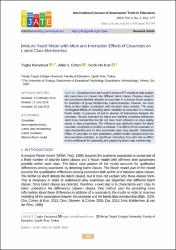Mixture Rasch Model with main and interaction effects of covariates on latent class membership
Künye
Karadavut, T., Cohen, A.S. & Kim, S.H. (2019). Mixture Rasch Model with Main and Interaction Effects of Covariates on Latent Class Membership. International Journal of Assessment Tools in Education, 6(3), 362-377. https://doi.org/10.21449/ijate.592789Özet
Covariates have been used in mixture IRT models to help explain why examinees are classed into different latent classes. Previous research has considered manifest variables as covariates in a mixture Rasch analysis for prediction of group membership. Latent covariates, however, are more likely to have higher correlations with the latent class variable. This study investigated effects of including latent variables as covariates in a mixture Rasch model, in presence of and in absence of interactions between the covariates. Results indicated the latent and manifest covariates influenced latent class membership but did not have much influence on class ability means or class proportions. The influence was relatively higher for latent covariates compared to manifest covariates. The effects of the covariates on class membership and on item parameters were class specific. Substantial effects of covariates on item parameters yielded smaller standard errors for item parameter estimates. A significant interaction term also had an effect on the coefficients for predicting and explaining latent class membership.
Kaynak
International Journal of Assessment Tools in EducationCilt
6Sayı
3Bağlantı
https://doi.org/10.21449/ijate.592789https://app.trdizin.gov.tr/makale/TXpNek1Ua3pNdz09
https://hdl.handle.net/11436/5350


















